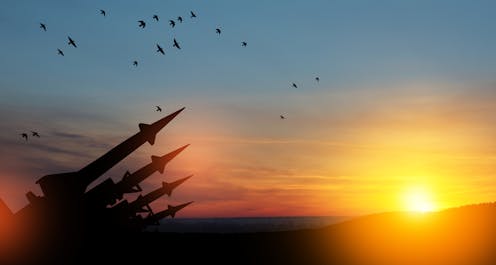
Christopher Nolan’s biopic of J. Robert Oppenheimer has revived morbid curiosity in the destructive power of nuclear weapons. There are now an estimated 12,512 nuclear warheads.
A war in which even a fraction of these bombs were detonated would create blast waves and fires capable of killing millions of people almost instantly. The radiation-induced cancers and genetic damage would affect the remaining population for generations.
But what sort of world would remain amid the radioactive fallout? For the last four decades, scientists modelling the Earth system have run computer simulations to find out.
Using their knowledge of chemistry and climate modelling, atmospheric scientists Paul Crutzen and John Birks wrote a short paper in 1982 which suggested a nuclear war would produce a smoke cloud so massive that it would cause what became known as a nuclear winter. This, they claimed, would devastate agriculture and with it, civilisation.
A year later, scientists from the US and Soviet Union confirmed first that cities and industrial complexes hit by nuclear weapons would indeed produce much more smoke and dust than burning the equivalent area of forest. And second, this global layer of smog would block out sunlight, causing conditions at Earth’s surface to become rapidly colder, dryer and darker.
Climate modelling shows the reduced sunlight would plunge global temperatures by up to 10˚C for nearly a decade. These freezing conditions, combined with less sunlight for plants to photosynthesise, would have catastrophic consequences for global food production and lead to mass starvation worldwide.
Modern climate models are much more sophisticated than those used in the 1980s. And while there are fewer nukes in working order today, more recent results from computer simulations suggest that the grim prophecy delivered by scientists 40 years ago may actually have been an underestimate.

Clear and present danger
Environmental scientists led by Alan Robock at Rutgers University in the US argued in a recent paper that the nuclear winter theory helped end the proliferation of nuclear weapons during the cold war. In 1986, President Ronald Reagan and General Secretary Mikhail Gorbachev took the first steps in history to reduce the number of nuclear weapons while citing the predicted consequences of a nuclear winter for all life on Earth.
At the height of the arms race in the mid-1980s there were over 65,000 nuclear weapons. The reduction in the global nuclear arsenal to just over 12,000 (of which 4,000 are on operational standby) has ebbed the threat of all-out nuclear war, prompting some to question whether the limited climate models used in the 1980s had understated the consequences of a global nuclear war.
Newer and more sophisticated climate models, the ones used to model future climate changes caused by the burning of fossil fuels, suggest the opposite is true.
With the largest possible nuclear exchange between the US and Russia, new models suggest the ocean would cool so profoundly that the world would be thrust into a “nuclear little ice age” lasting thousands of years.
Of course, there are seven other nuclear states: China, France, India, Israel, North Korea, Pakistan and the UK. Scientists have modelled that even a limited nuclear war between India and Pakistan could kill 130 million people and deprive a further 2.5 billion of food for at least two years.
A nuclear war is unlikely to remain limited, however. What starts with one tactical nuclear strike or a tit-for-tat exchange between two countries could escalate to an all-out nuclear war ending in utter destruction. A global nuclear war including the US, Europe and China could result in 360 million people dead and condemn nearly 5.3 billion people to starvation in the two years following the exchange.
The threat remains
Scientific modelling allows us to peer into the abyss of a nuclear war without having to experience it. Forty years of scientific research into these possibilities encouraged the adoption of a United Nations treaty on the prohibition of nuclear weapons in 2017 – ratified by most countries but not the nine nuclear powers.
The international campaign to abolish nuclear weapons was awarded a Nobel Peace Prize that same year for its work in highlighting the catastrophe that would result from any use of nuclear weapons.
But the war in Ukraine has brought old fears to the surface. President Vladimir Putin of Russia has threatened a limited use of nuclear weapons as part of the conflict, and a single launch could escalate into a regional or even global exchange that would plunge billions of people into a world so harrowing we can barely comprehend it.
Robock said that it is now “even more urgent” for scientists to study the consequences of detonating nuclear weapons and ensure as many people as possible know about them. And, ultimately, to work for the elimination of these weapons. The threat of nuclear war has not gone away, and a nuclear ice age which would doom much of life on Earth for millennia is still a possibility.

Don’t have time to read about climate change as much as you’d like?
Get a weekly roundup in your inbox instead. Every Wednesday, The Conversation’s environment editor writes Imagine, a short email that goes a little deeper into just one climate issue. Join the 20,000+ readers who’ve subscribed so far.
Mark Maslin is the UNFCCC designated point of contact for UCL. He is co-director of the London NERC Doctoral Training Partnership and a member of the Climate Crisis Advisory Group. He is a member of the Sopra-Steria CSR Board, Sheep Included Ltd, Lansons and NetZeroNow advisory boards. He has received grant funding from the NERC, EPSRC, ESRC, DFG, Royal Society, DIFD, BEIS, DECC, FCO, Innovate UK, Carbon Trust, UK Space Agency, European Space Agency, Research England, Wellcome Trust, Leverhulme Trust, CIFF, Sprint2020, and British Council. He has received funding from the BBC, Lancet, Laithwaites, Seventh Generation, Channel 4, JLT Re, WWF, Hermes, CAFOD, HP and Royal Institute of Chartered Surveyors.
This article was originally published on The Conversation. Read the original article.







